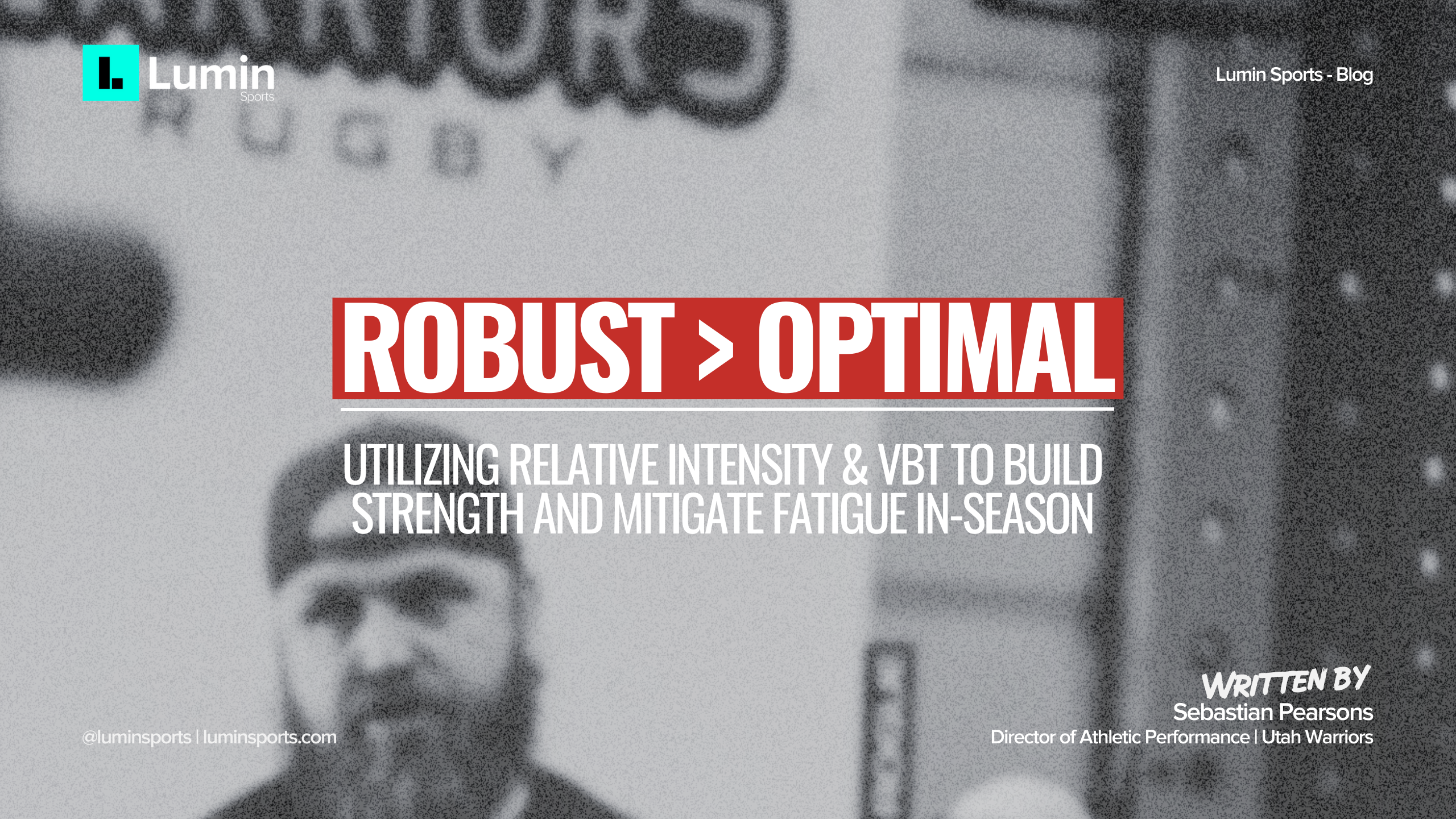Robust > Optimal: Utilizing Relative Intensity & VBT to Build Strength and Mitigate Fatigue In-Season

Written by Sebastian Pearson
Director of Athletic Performance, Utah Warriors, Major League Rugby
__
The fault in % based training is well documented but there isn't a single method of training that is perfect. VBT as a system is great but there are many moving parts that can go wrong. However, I feel that like with most things the answer does not exist at the ends of the spectrum but in the middle and a combination of both is the way to go.
This middle ground I'm talking about is the combination of velocity bandwidths and relative intensity bandwidths. If you aren't familiar with Relative Intensity (RI), it is a way of utilizing percent-based training, but it accounts for ‘internal’ load (effort/exertion or relative intensity) as well as “external” Load (%1RM or Absolute intensity). It is a more refined version of the training max concept that acknowledges that athletes are not always at optimal levels of readiness to train so to under shoot on absolute load will help mitigate over training.
Relative intensity improves on this in my opinion, RI works based on these principles
If a single rep at 100% of 1RM requires 100% effort from the athlete, then conversely a single rep at 85% of 1RM requires an 85% effort from the athlete.
If an athlete is required to complete more than a single rep at 85% then it requires greater than 85% effort (85% x 6 reps = 100% effort or 6RM)
If we want the athlete to finish the set at 85% effort then the absolute intensity must be dropped below 85% 1RM (1 x 5 @ 75% = 85% RI)
As a coach you plan intensity based on the completion of a set not of a single rep.
These principles can also be applied to VBT
Terminal velocity or velocity at 1RM is consistent for not only single reps but also the final rep of an AMRAP set.
Velocities associated with lower percentages are then also consistent for single and multi-rep sets.
The velocity at which an athlete completes a single rep represents the associated %1RM ( .68 m/s = 80% 1RM on back squat) and represents the absolute intensity
The average velocity of an entire set completed by an athlete represents the effort required of the athlete to complete that set (1 x 4 @.68 m/s average = 80% effort) and is the relative intensity.
The advantage of utilizing relative intensity is that it provides bandwidths of intensity that as a coach you can keep your athletes in for a longer duration than if you were just utilizing percent-based training. This is particularly beneficial in-season when a slow burn approach is more appropriate. In-season there is less of an emphasis on adaptation and a greater emphasis on expression of physical qualities and choosing principles that have the biggest return on investment. An example of this is having athletes' strength work primarily exist in the 80-90% bandwidth. This zone allows for the development of strength while also having crossover benefits to power development which I think we can all agree that doubling up on these qualities is well worth it in season. The 80-90% zone correlates to .7 - .5 m/s velocity zones and with the principle of relative intensity I can plan my sessions to remain in these bandwidths.
This is an example of how I would plan out Back Squat intensity for my athletes in season:
Block 1 - 80% Relative intensity
Week 1 - 4 x 4 @ .7-.65 m/s avg = 72% 1RM
Week 2 - 4 x 3 @ .7-.65 m/s avg = 74%
Week 3 - 5 x 2 @ .7-.65 m/s avg = 76%
Week 4 - 6 x 1 @ .7-.65 m/s avg = 80%
Block 2 - 85% Relative Intensity
Week 1 - 4 x 4 @ .65-.6 m/s avg = 76% 1RM
Week 2 - 4 x 3 @ .65-.6 m/s avg = 78%
Week 3 - 5 x 2 @ .65-.6 m/s avg = 80%
Week 4 - 6 x 1 @ ..65- .6 m/s avg = 85%
By reducing the volume each week and holding the velocity in the same zone, this keeps the relative intensity the same each week while allowing the absolute intensity to increase and allow for progressive overload to occur in a very manageable and beneficial way for the athlete in season.
Rather than touch absolute intensities on a weekly basis my athletes are touching absolute intensities every 3-4 weeks depending on the length of the block. As I mentioned, this allows for a very slow burn approach to the adaptation and development of the outputs but mitigates fatigue in season not only by sticking to velocity zones which are inherently auto regulated but also only requires the athlete to make marginal increases in load from week to week while also reducing volume. The combination of all these principles means that the training experience is very consistent for the athlete. We are not pulling resources from the body and its need to recover from practices and all the things required of the athlete in-season while also giving them what they feel like they need to be prepared or confident for game day.
This may not be the optimal way for strength development and it may not even apply to every individual within the team, but for the context of in-season training this method is far more robust because it does allow for the development of strength and power while also accounting for and mitigating increases in fatigue and soreness. This way the athletes can focus on and prioritize being at their best for the actual competition itself and not the weight room.
__________
Follow the Utah Warriors: https://www.instagram.com/utahwarriorsrugby/
Want to learn more about VBT Training? Read this great article from Sportsmith HERE